Abstract
This paper examines the resource block and power allocation in the power domain non-orthogonal multiple access (PD-NOMA) based cellular device-to-device (D2D) systems. To improve the energy efficiency of the D2D systems and to manage the mutual interference level as well as the quality of service (QoS) requirement of cellular users, different power level is applied to the D2D users sharing the same resource blocks (RBs) to the legacy users. It is essential to design an efficient resource block and power allocation method for PD-NOMA based cellular D2D systems which guarantee the successive interference cancellation (SIC) order in the power allocation solution. In this paper, we propose an iterative algorithm of resource block and power allocation for cellular D2D system which incorporates the SIC aware geometric water filling (GWF) method in the power allocation solution. It is shown that the proposed SIC aware geometric water filling achieves higher energy efficiency compared to iterative water-filling (IWF) power allocation and the GWF based orthogonal multiple access (OMA) method.
1. Introduction
The ever-increasing number of mobile applications and user demands eventually diverse on new technological and architectural solutions for the energy and spectrum efficient next generation of cellular networks (i.e., 5G networks). The device-to-device (D2D) communication is one of the technological solutions of 5G networks. In D2D communication, the cellular devices work as D2D users communicate with each other bypassing the base station. The D2D communication efficiently manages the proximity services such as local advertising, content sharing etc., among the users. Initially, the cellular relay networks are considered as D2D communication, now it supports the local demand of users such as content sharing, gaming, advertising, public safety [1,2]. In the cellular D2D communication, the cellular users support mode selection techniques and work as D2D users to communicate with other D2D users over the direct cellular link bypassing the base station [1,3].
For the spectrum efficiency of the cellular D2D systems, the D2D users share the same resource blocks or spectrum of cellular users in an orthogonal or non-orthogonal way [4,5]. The D2D supported in LTE and LTE-A networks utilize orthogonal multiple access (OMA) technique that uses a dedicated portion of the spectrum for D2D users. However, the OMA supported D2D communication is expensive due to the limitation of the spectrum. On the other hand, the next-generation cellular networks consider the non-orthogonal multiple access (NOMA) technique as a candidate solution for spectrum sharing. In the OMA technique, devices are used the orthogonal spectrum to avoid interference. In the NOMA technique, multiple devices can share the same spectrum using NOMA successive interference cancellation (SIC) principles. The NOMA based spectrum sharing is considered a better solution for D2D communication to improve spectrum efficiency [1,6].
In the NOMA supported D2D communication, the D2D, and cellular users utilize the same spectrum in a non-orthogonal way. The power domain NOMA (PD-NOMA) is one type of NOMA method that uses different power levels for users to provide services in the same spectrum or resource block. In the NOMA cluster, if two users use the same spectrum, the user who has a higher channel gain uses less power to avoid intra-cluster interference. At the receiver side in PD-NOMA, each user applies the SIC method to decode the original signal from the superimposed signal [7]. In this work, we consider the resource allocation problem in PD-NOMA supported cellular D2D networks. We also investigate the energy efficiency factor of cellular D2D systems utilizing PD-NOMA method.The non-orthogonal resource allocation problem of cellular D2D systems need to address the following issues:
- Does the PD-NOMA supported resource allocation consider the energy efficiency of the networks? In this work, we consider an energy-efficient resource allocation method of downlink cellular D2D systems. We formulate a joint radio resource and power allocation optimization problem of PD-NOMA supported cellular D2D systems with the objective to maximize the energy efficiency of the D2D system.
- Does the non-orthogonal resource allocation method consider the resource block association and the QoS requirements of cellular users’ constraints?In the joint optimization problem, we consider the RB association and minimum data rate constraints.
- How does the SIC constraint consider in the resource allocation problem?In the resource allocation problem, we consider the SIC constraint.
- Does the non-orthogonal resource allocation method satisfy the maximum power requirement of the base station?We consider the maximum power budget of each resource block and base station.
- Does the power allocation method in PD-NOMA consider the SIC decoding order?In this work, we consider the above issues in the PD-NOMA based cellular D2D resource allocation problem.
1.1. Related Works
The OMA and NOMA methods have been investigated in resource allocation problems in cellular D2D systems [8,9,10]. A summary of these works and the solution approaches are given in Table 1. The resource allocation in cellular D2D systems considers resource blocks (RBs) or subcarriers (SCs) and power allocation to maximize the system efficiency in terms of spectrum efficiency (SE) and energy efficiency (EE). Authors in [11,12] proposed an energy-efficient resource allocation method for OMA supported D2D systems where one D2D pair shares one cellular user radio resource. An iterative algorithm is proposed to satisfy the signal-to-interference-noise ratio (SINR) and data rate constraints of D2D and cellular users. Similarly, in [8] authors considered the SINR and data rate constraints in multi-class D2D resource allocation problems to improve the spectrum efficiency of the D2D systems. In [8], the authors considered the geometric water filling (GWF) based power allocation in OMA supported D2D systems. The geometric water filling is the proven method for the optimal resource allocation in the communication networks and it shows the lowest complexity than the other conventional water filling methods [13]. In this paper, we consider the SIC decoding order in the GWF method and propose a novel power allocation solution for both D2D and cellular users sharing the same resource block.

Table 1.
Summary of resource optimization problems in cellular device-to-device (D2D) networks.
The NOMA method has been studied in [9,10] to maximize the sum rate of the cellular D2D systems. The minimum data rate requirement of cellular users and SIC constraint are considered in [9]. Authors in [10] introduce the D2D group concept where many D2D pairs can share one cellular user channel. However, the resource allocation policy is affected by the optimal choice of device grouping. Different from the above work, we investigate the energy efficiency performance of the downlink cellular D2D systems while considering the QoS requirement of cellular users, SIC decoding order, power budget constraints and also adopt the GWF method in the power allocation solution.
1.2. Contributions and Organization
In this paper, we consider an energy-efficient resource allocation method of downlink cellular D2D systems. We formulate a joint radio resource and power allocation optimization problem of PD-NOMA supported cellular D2D systems. We modify the geometric water filling (GWF) method to support the SIC and maximum power constraint. The main contributions of this paper are as follows:
- We consider joint resource block and power allocation for D2D users, where the radio resource allocation method supports a one-to-one resource block allocation constraint.
- To solve the joint optimization problem, the original problem is transformed into the subtractive linear form and solved it according to the Dinkelbach theorem and iterative algorithm.
- The proposed iterative algorithm of resource block and power allocation method incorporates SIC aware geometric water filling based power allocation which satisfies the NOMA SIC principle during the user-RB power allocation procedure.
- It is shown that the proposed SIC aware geometric water filling achieves higher energy efficiency compared to other power allocation approaches and the iterative water-filling-based PD-NOMA method.
The rest of the paper is organized as follows. In Section 2, the system model for resource block and power allocation in the cellular D2D system is described. The corresponding energy-efficient resource optimization problem, objective and constraint sets are presented in Section 3. The proposed iterative resource allocation method is described in Section 4. Section 5 provides the simulation results of the proposed method. Finally, Section 6 concludes the paper.
2. System Model and Assumptions
We consider a PD-NOMA enabled D2D based cellular system, as shown in Figure 1, where number of D2D pairs, are covered by a single cell B. For simplicity, we assume that the system supports a total number of resource blocks (RBs), indexed by jointly assigned by the base station to all cellular users (CUs) and D2D pairs. The system supports a total number of users (UEs) , where CUs are indexed by and D2D pairs are denoted by . To improve the spectrum efficiency, we assume that CUs and D2D pairs share the same set of resource blocks in an underlaid approach. According to the NOMA principle, we assume that D2D users share cellular users’ RBs. A PD-NOMA enabled D2D based cellular system, the BS needs a careful RB assignment to the D2D users so that it will not interfere with the CUs and also maintain the NOMA SIC principle. Hence, the goal of this paper is to optimize the downlink RB assignment and power allocation of D2D pairs jointly to improve the energy efficiency of the D2D system while maintaining the QoS requirement of CUs. For a summary of symbols and parameters, a list is provided in Table 2.

Figure 1.
A D2D-enabled cellular networks.

Table 2.
List of symbols.
The channel gain from D2D pair m on RB r is denoted as . The distance between D2D users is denoted as . The allocating power from D2D users m on RB r is denoted as , where denotes the maximum power of BS. Let be the channel to noise ratio (CNR) of user k, where . The CNRs of users on RB r are ordered as
For simplicity, we assume that each RB is often restricted to be assigned to two users [14], which is helpful to reduce the error propagation of SIC. In this paper, D2D pair m uses the same RB r of cellular user c. The D2D pair m desires to decode and remove interference from the superposition signal of CU c using SIC on the rth RB. The interference cancellation is successful if the D2D user m received SINR for the CU c signal is larger or equal to the received SINR of CU c for its own signal [7,15]. Therefore, the condition of SIC decoding order between the mth D2D and cth CU is given by
The signal-to-interference-noise ratio (SINR) achieved by D2D user m on RB r using SIC can be written as
Then, data rates of cellular and D2D users on RB r are given respectively by
where denotes bandwidth allocated to each RB.
3. Energy Efficiency Resource Allocation in PD-NOMA Based D2D Systems
The objective of resource allocation is to maximize the energy efficiency () of D2D systems by utilizing non orthogonal spectrum access techniques. The EE can be measured by the total achievable data rate in D2D system divided by total power, written as:
Notation indicates RB allocation between D2D user m on RB r with if RB r is assigned to D2D user m and otherwise . indicates that CU c share RB r to D2D user m.
We define the following constraint sets in order to maximize in a cellular D2D system. In constraint C1, each RB is associated with only one D2D pair. Similarly, constraint C2 ensures that CU and D2D users share only one RB.
Constraint C3 and C4 ensures the maximum power budget of each RB () and base station respectively, i.e.,
D2D users share the same RB of cellular users. To avoid interference and maintain SIC decoding order, constraints C5 ensures the SIC decoding order in terms of power allocation, i.e.,
As the CU shares the same RB with the D2D user, the minimum rate constraint ensures the QoS of CU in C6 as
where is the minimum data rate threshold value for CU.
Problem Formulation
The goal of this paper is to maximize the EE of D2D systems obtaining rate and power among all D2D pairs while guaranteeing the minimum rate requirement of all CUs. To achieve this, an optimization algorithm is required to perform EE resource allocation (e.g., RB and power allocation) and SIC decoding. The mathematical formulation of energy efficiency resource allocation problem in the cellular D2D system is as follows:
In P1, the objective is to maximize the energy efficiency of the cellular D2D system by allocating the same radio resources to both CU and D2D users. There are two optimization parameters considered in this problem: (i) RB allocation of D2D users (i.e., and ) and (ii) power allocation for D2D users (i.e., ) and CUs (i.e., ).
4. Iterative Algorithm for Resource Allocation
The fractional objective function in P1 and the C1 and C2 constraints turn the problem P1 into a mixed integer non-convex fractional programming problem. The objective function in P1 can transform to the subtractive linear form [16,17] and solved according to the Dinkelbach theorem [18]. The relaxed problem can be represented by:
The iterative algorithms to obtain and resource allocation policy (i.e., ) are given in Algorithm 1 and Figure 2, respectively.
| Algorithm 1: Iterative algorithm for obtaining . |
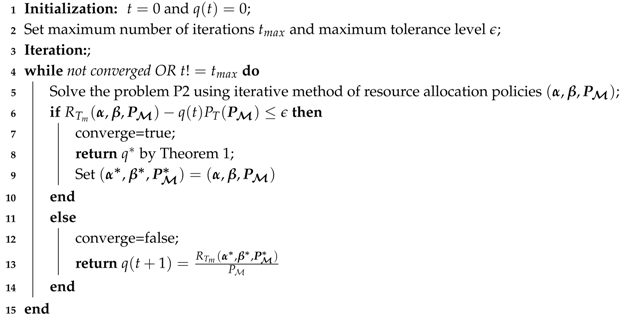 |
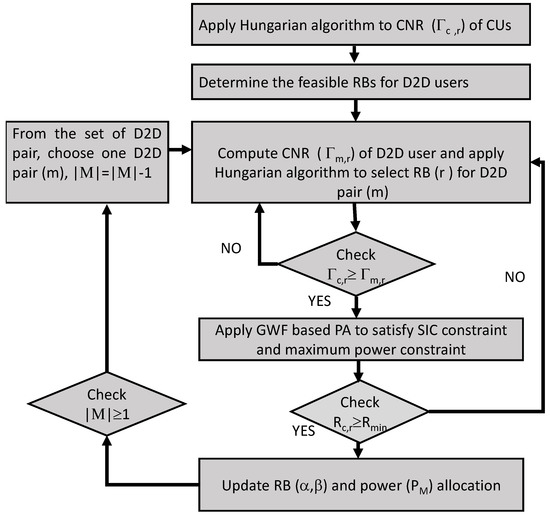
Figure 2.
Iterative method for obtaining resource allocation .
In the cellular D2D system, we assume that the resource allocation policy is centrally coordinated by the base station. Using the channel state information of the cellular users, the feasible set of resource blocks for D2D users are determined. The key steps of the proposed solution are as follows:
- Each D2D user selects one RB from the feasible set of RBs, computes CNR () and compares this value with the CNR () of the cellular users. To avoid interference, the condition in (1) is needed to satisfy for RB selection for D2D users.
- After getting the RB for D2D user, an iterative SIC aware geometric water filling method is applied. In the PD-NOMA based cellular D2D systems, the cellular and D2D user in the same RB use different power levels to satisfy the SIC condition. In the GWF based power allocation, the user-RB power is allocated in such a way that the user with the highest CNR gets the lowest power.To implement this approach, the step depth in GWF follows the condition in (1) that accordingly represent the highest CNR to highest depth, so that the lowest power is allocated to it. Therefore, we represent the step depth, , as the inverse of normalized CNR asThe user will be D2D user m and cellular user c sharing then RB r in a non-orthogonal way.Figure 3 shows the NOMA SIC aware GWF procedure. Using Equation (6), the inverse of normalized CNR is represented as the largest depth, hence, we can apply the GWF method to find the explicit solution of power allocation, which is defined as follows
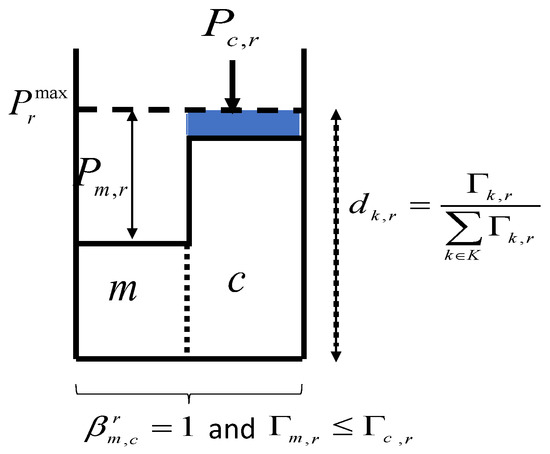 Figure 3. Non-orthogonal multiple access (NOMA) successive interference cancellation (SIC)-aware geometric water filling (GWF) procedure.Here, denotes the maximum water level and denotes the allocated power in level.
Figure 3. Non-orthogonal multiple access (NOMA) successive interference cancellation (SIC)-aware geometric water filling (GWF) procedure.Here, denotes the maximum water level and denotes the allocated power in level.
Numerical Examples of Iterative method
The RB allocation of CUs and D2D pairs is estimated as follows:
The maximum number of users supported by a cellular D2D system is , where the number of CUs is and the number of D2D pairs is using RB of CU in a non-orthogonal way. The total number of RBs is . Here, the notation , and refer the resource block, cellular user and D2D pair respectively and subscript 1 denotes their index. The symbol → means uses, i.e., → means the cellular user one uses the resource block one. Let the CNR of all CUs is given as follows
For the RB allocation to the CUs, we can apply Hungarian matching algorithm [19] in , get one-to-one matching solution i.e., →, → and →.
As the D2D pairs share the same RB to the CUs, the feasibility set of RB to the D2D pair is . Assume the CNR information of D2D pair is as follows
Similarly for the RB allocation to the D2D pairs, we apply Hungarian matching algorithm in (9) and check the CNR constraint , get the RB allocation for D2D pairs as follows
→, that is D2D pair one uses the RB one. Also →, the shares the with the and set .
Similarly, →, where the shares the with the and set
The power allocation based on SIC aware GWF method is estimated as follows:
Assume that the total maximum power budget of the base station is dB. Let the maximum power budget of each RB is dB. Using RB maximum power ( and RB allocation () information among D2D and CUs, we can compute the user power by utilizing SIC aware GWF method. Figure 4 shows the results of the power allocation of and which utilizes the calculation of using Equations (6) and (7).
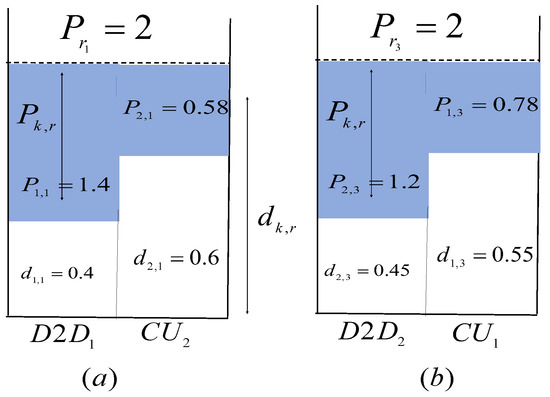
Figure 4.
The results of the power allocation of and which utilizes the NOMA-SIC based GWF method to estimate user power (a) dB (b) dB.
5. Simulation Results
In this section, we present some numerical results for energy-efficient resource allocation in PD-NOMA supported a single cell cellular D2D system. The cell area is 100 m × 100 m with a centrally located base station. The maximum distance between the D2D transmitter and the receiver is 10 m. We assume that the system supports the maximum number of resource blocks . The D2D pairs and the cellular users are distributed randomly according to the Poisson point process. We set dBm and dBm. Other simulation parameters are listed in Table 3. The log-distance-based path loss model is considered. All the simulation results are averaged over 1000 realizations. The sum data rate and energy efficiency performance of our proposed GWF based power allocation method is compared with GWF based OMA method [8] and iterative water filling based PD-NOMA [20] method.

Table 3.
Simulation parameters.
Figure 5 shows the performance of the sum data rate versus the number of D2D pairs for different power allocation methods in OMA and NOMA. It can be observed that the sum data rate performance of NOMA is better than OMA which is also reported in [15]. This can be explained by the NOMA method supports more users than the OMA method which in turn improves the sum data rate performance. In PD-NOMA, two RB allocation methods, i.e., Hungarian matching and greedy algorithm are compared. The Hungarian method is adopted in our proposed solution PD-NOMA GWF and the greedy method is adopted in PD-NOMA IWF. The sum-rate performance of GWF is better than IWF based PD-NOMA method because, in the radio resource (i.e., RB) allocation, the Hungarian matching algorithm finds one-to-one matching solution for D2D and cellular user depending on the highest channel gain and SIC constraint. On the other hand, the greedy method does not consider the highest channel gain and SIC constraints in the radio resource allocation.

Figure 5.
Performance of sum data versus number of D2D pairs with different power allocation method in OMA and NOMA.
The energy efficiency performance of the PD-NOMA method is compared for two power allocation approaches i.e., SIC aware geometric water filling and iterative water-filling method, as shown in Figure 6. It is observed that the EE performance of PD-NOMA GWF is better than others. The GWF method follows the SIC principal when estimates the step depth using the Equation (6). According to the SIC principal, the user who has the highest channel gain gets the lowest power whereas the IWF based PD-NOMA iteratively allocates power as long as the maximum power constraint is satisfied.
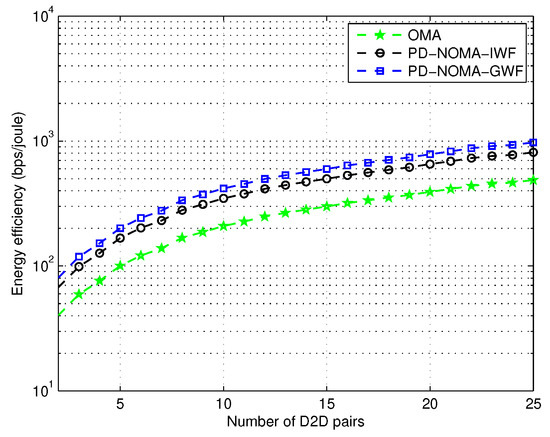
Figure 6.
Energy efficiency performance versus number of D2D pairs when .
Figure 7 shows the energy efficiency performances of PD-NOMA and OMA for the different minimum data rate requirements of cellular users. It is observed when the minimum data rate requirement of cellular users is increased, the EE performance of both multiple access methods is decreased. However, the PD-NOMA GWF method shows the best EE performance than others. This is because when the minimum data rate requirement is increased, the PD-NOMA method supports a higher number of D2D users compared to the OMA method. Moreover, the PD-NOMA GWF method considers SIC order and maximum RB power constraint during the power allocation which increases the EE performance than the IWF based PD-NOMA method.
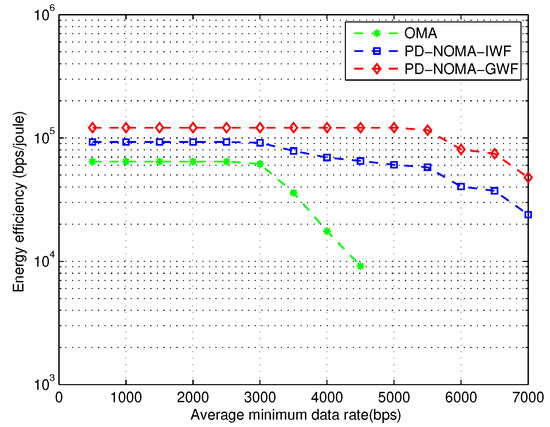
Figure 7.
Performance of energy efficiency with different minimum data rate requirements of cellular users.
6. Conclusions
In this paper, we proposed an iterative resource allocation method that incorporates the Hungarian algorithm for resource block allocation and successive interference cancellation aware geometric water filling method of power allocation for cellular D2D system. The D2D users use the same radio resources of the cellular users using the power domain non-orthogonal method. The proposed iterative resource allocation method has satisfied the resource allocation, successive interference cancellation, and maximum power constraints as well as QoS constraints of cellular users. The simulation results show that the proposed iterative algorithm improves EE in the D2D system through the non-orthogonal and SIC aware power allocation.
Author Contributions
The work presented in this paper is based on the study conception provided by M.S.A.-k. who contributed also to this work with the system model and research formulation. Code implementation, analysis and paper drafting have been done by L.F., L.K. works as a reviewer and prof-reader of this paper. All authors have read and agreed to the published version of the manuscript.
Funding
This research received no external funding.
Conflicts of Interest
The authors declare no conflict of interest.
References
- Dopper, K.; Rinne, M.; Wijting, C.; Ribeiro, C.; Hugly, K. Device-to-device communication as an underlay to LTE-advanced networks. IEEE Commun. Mag. 2009, 47, 42–49. [Google Scholar] [CrossRef]
- Li, Z.; Moisio, M.; Uusitalo, M.A.; Lunden, P.; Wijting, C.; Moya, F.S.; Yaver, A.; Venkatasubramanian, V. Overview on initial metis d2d concept. In Proceedings of the 1st International Conference on 5G for Ubiquitous Connectivity, Akaslompolo, Finland, 26–28 November 2014; pp. 203–208. [Google Scholar]
- Jo, M.; Maksymyuk, T.; Strykhalyuk, B.; Cho, C.H. Device-to-device-based heterogeneous radio access network architecture for mobile cloud computing. IEEE Wirel. Commun. 2015, 22, 50–58. [Google Scholar] [CrossRef]
- Feng, D.; Lu, L.; Wu, L.; Li, G.; Feng, G.; Li, S. Device-to-Device Communications Underlaying Cellular Networks. IEEE Trans. Commun. 2013, 61, 3541–3551. [Google Scholar] [CrossRef]
- Militano, L.; Orsino, A.; Araniti, G.; Molinaro, A.; Iera, A.; Wang, L. Efficient spectrum management exploiting d2d communication in 5g systems. In Proceedings of the 2015 IEEE International Symposium on Broadband Multimedia Systems and Broadcasting, Ghent, Belgium, 17–19 June 2015. [Google Scholar]
- Han, T.; Yin, R.; Xu, Y.; Yu, G. Uplink channel reusing selection optimization for Device-to-Device communication underlaying cellular networks. In Proceedings of the IEEE 23rd International Symposium on Personal Indoor and Mobile Radio Communications (PIMRC), Sydney, NSW, Australia, 9–12 September 2012; pp. 559–564. [Google Scholar]
- Yue, X.; Qin, Z.; Liu, Y.; Kang, S.; Chen, Y. A unified framework for non-orthogonal multiple access. IEEE Trans. Commun. 2018, 47, 5346–5359. [Google Scholar] [CrossRef]
- Ferdouse, L.; Ejaz, W.; Raahemifar, K.; Anpalagan, A.; Markandaier, M. Interference and throughput aware resource allocation for multi-class d2d in 5g networks. IET Commun. 2017, 11, 1241–1250. [Google Scholar] [CrossRef]
- Pan, Y.; Pan, C.; Yang, Z.; Chen, M. Resource allocation for d2d communications underlaying a noma-based cellular network. IEEE Wirel. Commun. Lett. 2018, 7, 130–133. [Google Scholar] [CrossRef]
- Zhao, J.; Liu, Y.; Chai, K.K.; Chen, Y.; Elkashlan, M. Joint subchannel and power allocation for noma enhanced d2d communications. IEEE Trans. Commun. 2017, 65, 5081–5094. [Google Scholar] [CrossRef]
- Jiang, Y.; Liu, Q.; Zheng, F.; Gao, X.; You, X. Energy Efficient Joint Resource Allocation and Power Control for D2D Communications. IEEE Trans. Veh. Technol. 2016, 65, 6119–6127. [Google Scholar] [CrossRef]
- Gandotra, P.; Rakesh, K.J. Energy efficient device to device communication using adaptive resource block allocation. Int. J. Commun. Syst. 2019, 32, 3922. [Google Scholar] [CrossRef]
- He, P.; Zhao, L.; Zhou, S.; Niu, Z. Water-filling: A geometric approach and its application to solve generalized radio resource allocation problems. IEEE Trans. Wirel. Commun. 2013, 12, 3637–3647. [Google Scholar] [CrossRef]
- Kang, J.; Kim, I. Optimal user grouping for downlink noma. IEEE Wirel. Commun. Lett. 2018, 7, 724–727. [Google Scholar] [CrossRef]
- Tao, Y.; Liu, L.; Liu, S.; Zhang, Z. A survey: Several technologies of non-orthogonal transmission for 5g. China Commun. 2015, 12, 1–15. [Google Scholar] [CrossRef]
- Chang, Z.; Wang, Z.; Guo, X.; Yang, C.; Han, Z.; Ristaniemi, T. Distributed resource allocation for energy efficiency in ofdma multicell networks with wireless power transfer. IEEE J. Sel. Areas Commun. 2019, 37, 345–356. [Google Scholar] [CrossRef]
- Amani, N.; Pedram, H.; Taheri, H.; Parsaeefard, S. Energy-efficient resource allocation in heterogeneous cloud radio access networks via BBU offloading. IEEE Trans. Veh. Technol. 2019, 68, 1365–1377. [Google Scholar] [CrossRef]
- Dinkelbach, W. On nonlinear fractional programming. Manag. Sci. 1967, 7, 492–498. [Google Scholar] [CrossRef]
- Kuhn, W.H. The hungarian method for the assignment problem. Naval Res. Logist. Q. 1955, 2, 83–97. [Google Scholar] [CrossRef]
- Fu, Y.; Salaün, L.; Sung, W.S.; Chen, S.C.; Coupechoux, M. Double iterative waterfilling for sum rate maximization in multicarrier noma systems. In Proceedings of the 2017 IEEE International Conference on Communications (ICC), Paris, France, 21–25 May 2017; pp. 1–6. [Google Scholar]
© 2020 by the authors. Licensee MDPI, Basel, Switzerland. This article is an open access article distributed under the terms and conditions of the Creative Commons Attribution (CC BY) license (http://creativecommons.org/licenses/by/4.0/).